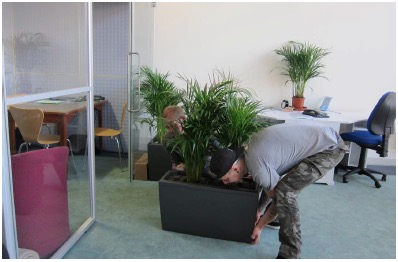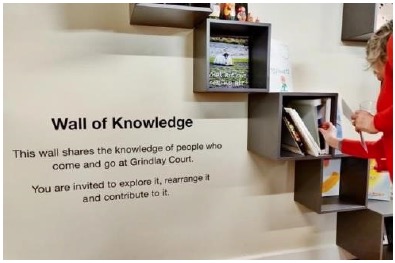Trauma-informed practice: toolkit
This trauma-informed practice toolkit (2021) has now been replaced by the Roadmap for Creating Trauma-Informed and Responsive Change: Guidance for Organisations, Systems and Workforces in Scotland (2023), supported by the National Trauma Transformation Program
Key Principle 3: Choice
Throughout the organisation, clients and staff are supported to make decisions and choices, and to set their own goals. The organisation recognises that giving people choice can help address power imbalances. Clients and staff therefore have meaningful choice and a voice in the decision-making process of the organisation and its services.
Toolkit
? In what ways do staff members recognise and address aspects of the physical environment that may be retraumatising, and work with either a) improving the environment and/or b) with people on developing strategies to deal with this?
Physical environment
Several organisations involved staff and service users in the design and development of the physical environment. One case study area described the establishment of a focus group of service users with the specific remit of advising on the development of a trauma-informed environment. Clients were at the core of the decision-making process, determining the colour scheme, choice of music in public areas and style of furnishings in the reception and interview rooms. Clients were also involved in the practical implementation of the groups recommendations

Clients involved in choosing the layout of the reception

Artwork in reception area
Engagement and Involvement
All case study areas recognised the importance of choice for service users and attempted to offer it wherever possible. Interviewees noted that offers of choice helped to reduce power differentials between staff and clients, promoting a sense among service users that they were being treated with respect. Staff noted in particular, that by offering choice in the context of a professional relationship, they were modelling the dynamic of a healthy interpersonal relationship and in so doing were helping to prepare clients for the decisions they would be required to make in real-life settings.
The principle of choice was most commonly referred to in the context of appointment scheduling, issues relating to non-attendance, or the application of discharge policies. Most services highlighted the need for maximum flexibility, with some services responding to high rates of non-attendance by modifying their practices and procedures multiple times. One service described a practice of operating "under the radar", keeping clients on the books when formal policy dictated that they should be discharged due to non-attendance.
"…it wasn't like they would give you a time or a day, they would say, I'm free this day and this day, and what time would suit you?"
"…I didn't feel that pressured, if I was having a bad day or that, I knew that it was alright...to have a day off."
"I've had other interactions with other organisations where I've contacted them by email and... I find it difficult to use the phone, and they've insisted that I phone. And I've said, well, I'm really not comfortable doing that and it's basically like too bad, you know, get lost."
"…we've gone through lots of iterations of how we offer care, so we run drop-in surgeries, we've run booked appointments on the day, we've run longer booked appointments.…so we would tend to frame that within trauma-informed care, 'cause it's about trying to be collaborative and meet people where they're at." (GP)
Working in the wake of a global pandemic presented particular challenges with regard to the capacity of some organisations to offer choice.
"…at the moment with COVID on the go, we're trying to offer booked appointments only, but we do still have people turning up….pre people being a bit more signed up to all of this, the idea of trauma-informed care, they would have just seen that as problematic….the person would often get, you know, 'why are you here' response. What we try and do now is try and say, you know, it's great you've turned up…and some days a doctor…is available to see a person, but other days they're not. So we'll try our best to either get them to see a nurse or get them to see a pharmacist."
In some case study areas, interviewees explained that their ability to offer choice was compromised by the organisation's primary purpose, its culture or its policies. In these circumstances attempts were made to embed an element of choice, however small, in the daily routines of the organisation whenever possible. For example, in the trauma-informed residential house, children were given the choice of how to paint and decorate their bedroom, or in education, a choice of activities.

"We have a lot of children who struggle in the afternoons as they go to bed late, so we allow them to choose activities when they can't concentrate...so they don't kick off…There's always a 'choice' time but we are always quite structured because that's what these children need. They may have little structure at home…they can choose a book they want me to read." (Education)
"…so part of how you could have more choice is you have more options. You say right, okay, we recognise that you may be at a different stage, so maybe psychology isn't for you, but there is this, so if you want to…if this isn't right for you, there is an option." (Mental Health)
"…being able to negotiate a little bit with people, about what's going to work for them, and what's going to make it most element of choice, however small, in the daily routines of the organisation wherever possible so that they're able to come and be able to engage". (CJSW)
Toolkit
? How do the organisation's written policies and procedures include a focus on trauma and issues of safety and confidentiality?
? How do the organisation's written policies and procedures recognise the pervasiveness of trauma in the lives of people (using the services and working in them), and express a commitment to reducing retraumatisation and promoting well-being and recovery?
? What policies and procedures are in place for including trauma survivors/ people receiving services and peer supports in meaningful and significant roles in organisation planning, governance, policy making, services and evaluation?
? How can staff and clients be involved with developing a plan for improving engagement and involvement of survivors in service planning and delivery? Has budget been considered to support this?
Getting Lived Experience on Board
? Is an individual's own definition of emotional safety included in treatment plans?
Cross sector collaboration
One case study service re-launched as a Public Service Partnership between statutory and third sector services. The multi-agency partnership maximised choice for service users, expanding the options available to service users and facilitating the ability of the service to respond to a wide range of need.
Screening, assessment and treatment services
Another case study area described the development of a care pathway that actively encouraged clients to choose from a range of options, selecting the intervention that they believed would best meet their needs. Options included psycho-education courses, and groups focusing on emotion regulation, self concept, or relationships. Interviewees from another case study area described the importance of choice in the context of court orders.
Other services promoted choice by providing "Mind of My Own" facilities on tablet devices, enabling children and young people to express their preferences with regard to food, provide feedback on their feelings prior to LAC reviews, and identify preferred educational and recreational activities. Children and young people then had the option of communicating this information to their key worker, teacher, manager or child protection officer.
Contact
Email: sharon.glen@gov.scot
There is a problem
Thanks for your feedback